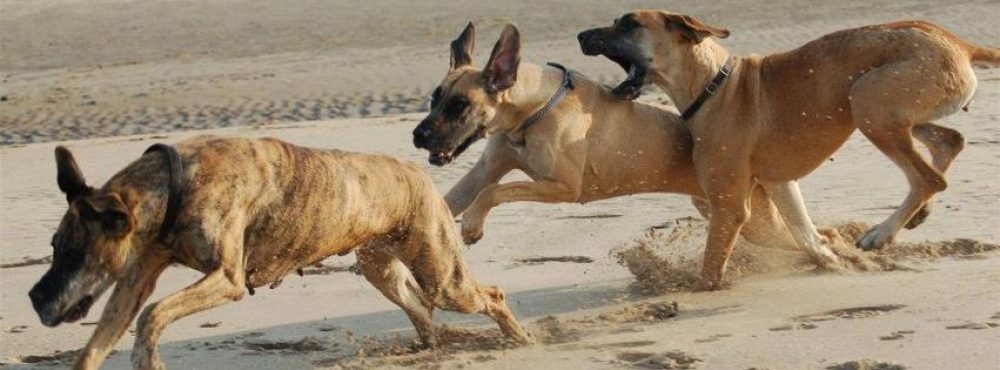The DNA Investigation into Wobblers
How to get your information and blood samples to
The Animal Health Trust
From the Breed Health Officer
Some twelve years ago the Great Dane Breed, at the instigation of Tony Pearce, the then Breed Health Officer, set up The Great Dane Register. This was to collate information on hereditary problems in the breed.
A survey was carried out and it was found that Wobblers and Dilated Cardiomyopathy were the two most serious.
At a meeting of The Combined Great Dane Clubs (now The Great Dane Breed Council) it was decided to investigate Wobblers (Cervical Spondylopathy) with the aim of developing a DNA test for the problem.
The cost of such a project then was £30,000.
This required pedigrees and blood samples being sent to the Animal Health
Trust.
Breeders have been very slow in submitting the required information, after twelve years we have still not had sufficient information to get the project started.
As you progress through this site you will find all the information you require to enable you to forward blood samples and pedigrees to The Animal Health Trust.
SECTION A: gives a brief description of WOBBLERS.
SECTION B: describes the project. You will need to download this and take it to your VET in case he asks why the blood sample is needed.
SECTION C: You will need to download this
section as your vet will have to send this with the blood sample. You must
take a pedigree with you when you go to the vet. If you are not in possession
of a 5-generation pedigree take a copy of the one given to you by the breeder.
If you need any further help I can be contacted:
SECTION A
Name: Cervical Vertebrae Instability/Cervical Spondylopathy (CVI) – otherwise known as Wobblers Syndrome.
Description
A degenerative condition, which affects Great Danes.
The basic problem occurs due to compression of the spinal cord when the cervical vertebrae (neck bones) are malformed, extruding or protruding. In extreme cases the rear end of the dog does not seem able to support it’s weight. The cervical vertebrae are, during the rapid growth stage i.e. 2 – 4 months, very vulnerable to damaging changes.
Age of noticeable onset in Great Danes is approximately 3 – 5 months.
The condition is not painful.
Signs:
The first sign for an unsuspecting owner is ataxia (uncoordinated or drunken like movement) most commonly in the hind quarters.
The hind legs may take on a wide gait when standing.
There may be difficulty in turning and the hind legs may cross over. Often there is difficulty in getting into position for urinating and defaecating.
Aetiology: Cause
- Inherited
- Overfeeding, over supplementation. Incorrect diet can be contributory factors
Investigation: Vet.
- Reflex tests
- X-Ray (not always conclusive)
- Myleogram (Vet College)
Treatment:
Medication (e.g. prednisolone) but only in mild cases.
Surgery – fixation of the vertebrae involved but if successful it only stabilises the condition.
Although medication is usually as successful as surgery neither will return the dog to normal.
Prognosis:
Extremely poor. This unfortunate condition can only be prevented by a combination of:
- Affected stock should not be bred from.
- Careful attention to diet during growth.
- Ensurance of steady growth of puppies up to the age of 6 months.
SECTION B
Canine Wobblers in The Great Dane
This condition is also known as cervical vertebral malformation. It is a developmental malformation and malarticulation of the cervical vertebrae in the neck. The main vertebrae affected are 5, 6 and 7. Clinical result from spinal cord compression in the affected area of the neck and include neck pain and gait abnormalities, which are often worse in the back limbs. The condition can progress to total paralysis.
The Great Dane is one of three breeds where the condition is believed to be inherited as a single recessive mutation. This means that the affected dog will have inherited a recessive mutant gene from it’s dam and a recessive mutant gene from it’s sire. If both parents are clinically normal, then they must both be carriers, by definition.
The Great Dane community in the UK has been attempting to collect material to further investigation this condition with the UK Great Dane population, in collaboration with the Canine Genetics section at The Animal Health Trust (AHT) in Newmarket. What is being requested is a pedigree of all affected dogs and a small blood sample, which is being stored at the AHT for future research. What will also be required eventually will be samples from an affected dog’s normal brothers and sisters and both of it’s parents. If we can also get samples from some of the grandparents, then all the better.
The pedigrees will allow confirmation that the condition is being inherited as a single recessive condition. The family collections of blood samples will allow the Trust to eventually use modern DNA technology to begin to track down the recessive mutant gene responsible for Wobblers in The Great Dane. This will almost certainly take place in two phases. The first phase will be to use the family DNA collections to locate the recessive mutant gene to a small region of one of the dog’s 39 chromosomes. Having roughly located the gene it will then be possible to take a closer look at the known genes in this area to try to identify one that might be involved in Wobblers, in other words to identify potential candidate genes. Once these candidates have been identified they will be analysed in both normal and affected Danes to see if evidence can be found to support a casual link between a gene and the condition.
SECTION C
Click on the icon to download the form for the submission of the blood sample ![]() in pdf format.
in pdf format.
To download the complete article to take to your vet click on the icon ![]()

You must be logged in to post a comment.